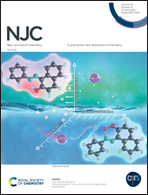The nature of π-hole spodium bonds in the HgLCl2(L = pyrrole, pyrazole, imidazole, pyridine, pyridazine, and pyrimidine) complexes: from noncovalent to covalent interactions†
Abstract
The nature of π-hole spodium bonds in the HgLCl2⋯ZH3/CH2Y complexes (L = pyrrole 1, pyrazole 2, imidazole 3, pyridine 4, pyridazine 5, and pyrimidine 6; Z = N, P, As, and Sb; Y = O, S, Se, and Te) has been studied using theoretical calculations. The electrophilicity of the π-hole in the tri-coordinated HgII complexes varies with the type of N-heterocyclic ligand. The strength and nature of the π-hole spodium bond is closely related to the properties of the Lewis bases. In the case of HgLCl2⋯ZH3, the strength of the π-hole spodium bond weakens as the nucleophilicity of the base decreases, following the sequence HgLCl2⋯NH3 > HgLCl2⋯PH3 > HgLCl2⋯AsH3 > HgLCl2⋯SbH3. The Hg⋯Z spodium bonds change from a partially covalent interaction to a close-shelled noncovalent interaction. The nucleophilic ability of CH2Y decreases in the order CH2O > CH2S > CH2Se > CH2Te, while the strength of the π-hole spodium bond follows the order HgLCl2⋯OCH2 < HgLCl2⋯SCH2 < HgLCl2⋯SeCH2 < HgLCl2⋯TeCH2. The Hg⋯Y spodium bond undergoes a transition from a close-shelled noncovalent to a partially covalent interaction, resulting in an incremental increase in the degree of covalence. The Hg⋯Te spodium bond exhibits certain characteristics resembling those of a coordinate covalent bond. The inter-orbital interactions observed in the formation of the HgLCl2⋯YCH2 complexes appear to be significantly stronger compared to those observed in the HgLCl2⋯ZH3 complexation.



 Please wait while we load your content...
Please wait while we load your content...